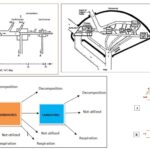what is the krebs cycle
what is the krebs cycle
Please login to submit an answer.
The Krebs cycle is a central metabolic pathway that plays a pivotal role in cellular respiration by oxidizing acetyl-CoA derived from carbohydrates, fats, and proteins into carbon dioxide while producing high-energy electron carriers such as NADH and FADH₂. These electron carriers subsequently donate electrons to the electron transport chain, driving ATP synthesis through oxidative phosphorylation. The cycle also generates intermediates required for biosynthetic processes, making it amphibolic (both catabolic and anabolic). Discovered by Sir Hans Adolf Krebs in 1937, the cycle consists of eight main enzymatic steps, beginning with the combination of acetyl-CoA and oxaloacetate to form citrate, followed by successive conversions leading back to oxaloacetate. Its importance lies in its role in energy production, carbon skeleton provision for biosynthesis, and regulation of metabolic flux within the cell.
- Share on Facebook
- Share on Twitter
- Share on LinkedIn
Helpful: 0%




